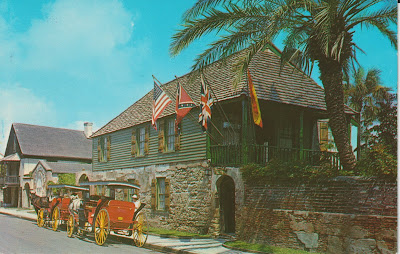Årstad Church, Hordaland, Norway, ca 1900
[from: Årstadposten, 24 August 1993]
This postcard of the Årstad Church was published in Årstadposten, issued dated 24 August 1993. Norvald Halland who helped with other information involving the Landaas family that subsequently ended up in the A Family Gathering: Landaas* book published last year, very kindly found the article and forwarded it on to me recently.
The stone church, as it looks in the picture, was built in 1890 and seats about 560 people. Some of the Landaas family members were christened at Årstad in the 1840s. However, since that was prior to 1890 there must have been earlier church or the parish could have met with another parish in the area and shared a different building. The card itself has a black and white photograph that has been tinted with color.
It was delightful to get this new information that not only included the postcard but a photograph of the area taken in 1920 and a line drawn map from 1934 with additions made in 1949, showing where the farm was located. All this area is now part of greater Bergen. The outline map from Wikipedia, below, shows each borough or district that once was separate and is now included in one "county" called Bergen. During the Viking era it is said that all of Årstad belonged to the king of Norway. It is also believed that one of our early Landaas ancestors received land for his service to the king. Lakesevåg and Fana are other places associated with the Landaas family and this outline helps to show how close the communities are to the city of Bergen and to each other. The communities of Lysekloster and Os, where the Landaas family also had connections, are further south.
Line map showing the communities near Bergen, Norway
[from: Wikipedia.org]
[from: Wikipedia.org]
Farms and houses in Årstad, in 1920, photo from the University of Bergen library, Norway
[from: Årstadposten, 24 August 1993]
Årstad, south of the city center, was merged into the city of Bergen in 1916. The boundaries are similar to the old municipality. The population in 2014 was almost 40,000. The farm Øvre-Landaastræt, where Mikkjel Johannesen Øvre Landaastræt and Kari Pedersdatter Fiskeset lived after leaving Fiskeset is highlighted in green on the photo, above. On the map below, the upper green inset is Øvre Landaastræt, the larger yellow inset also includes Landaas Hovegård, in the middle, and Nedre Landaastræt at the bottom of the inset.
Line drawn map with with insets added has farms and houses indicated, 1934, updated 1949
[from: Årstadposten, 24 August 1993]
Below: The parents of Peder Landaas. These were the grandparents the Landaas children often stayed with during the summers. Peder's two older girls, Mikkeline and Petra, had the task of watching the goats and sheep on the hillside.
Mikkjel or Mikkel Johannesen Øvre-Landaastræt (1812-1885)
[found on Ancestry.com]
[found on Ancestry.com]
Kari Pedersdatter Fiskeset (1818-1908)
[found on Ancestry.com]
[found on Ancestry.com]
I especially wanted to include this card and the additional photos plus the maps in the blog since I know some extended family members will be interested.
With many thanks to Norvald Halland in Norway for sending the link and sharing the card, the pictures and the maps.
For more information, see:
https://en.wikipedia.org/wiki/Årstad_Bergen
https://en.wikipedia.org/wiki/Årstad_Church
http://www.arstadposten.no/2019/01/12/se-kart-og-bilde-over-landas-gardene-for-utbyggingen/
-------------------------------------------------------------------------------------------------------------------
* The original plan was for each branch of the extended family to have its own book. At this time 4 volumes are completed and there are still at least 3 more in the Family Gathering series in the works. As I have published each volume in the series it has become evident that there will be a need for an extra book for corrections and additions once the set is completed. [Note: The books are available by invitation only. Family members who would like to order a copy can contact me privately and I will send the information.]
Cover of the Landaas family book, 2019













